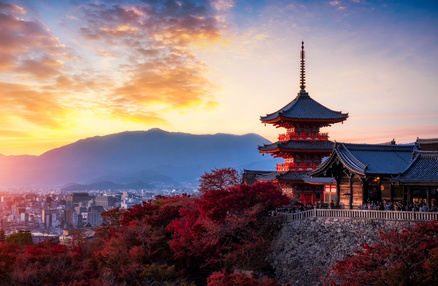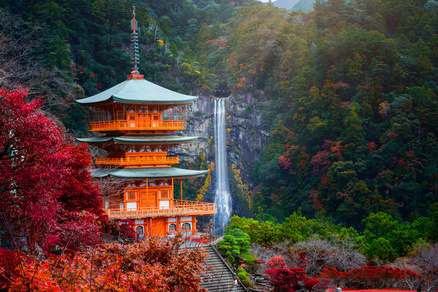
Japan is a country where centuries-old traditions exist alongside cutting-edge innovation, creating an experience that feels both timeless and futuristic. You can walk through serene temple grounds where monks chant ancient sutras, then within the same day find yourself surrounded by neon-lit skyscrapers and robot cafés. The old and new don’t just coexist—they complement each other. Tea ceremonies, kimono-clad geishas, and seasonal festivals still thrive amid a world of bullet trains, vending machines that sell everything imaginable, and some of the most advanced urban infrastructure in the world. This balance is one of the reasons every Japan travel guide encourages first-time visitors to embrace both the historical and the modern sides of the country.
From the energy of Tokyo’s Shibuya Crossing, where thousands surge forward at each green light, to the peaceful silence of a misty mountain temple in the Japanese Alps, the country offers an incredible variety of experiences. Food lovers can savour fresh sushi at local fish markets, while nature seekers can hike the trails of Yakushima or explore the snow-covered landscapes of Hokkaido. Whether your journey takes you to bustling cities or tranquil countryside, to historical castles or futuristic arcades, Japan rewards curiosity with beauty, depth, and unforgettable moments. No Japan travel guide is complete without highlighting this extraordinary diversity.
Best Time to Visit Japan
The best time to visit depends on what you want to see. Spring, from March to May, is famous for cherry blossoms that line streets, rivers, and parks across the country. It’s one of the most beautiful and popular seasons, so expect crowds. Summer is hot and humid but filled with traditional festivals like Kyoto’s Gion Matsuri. Northern regions such as Hokkaido offer cooler temperatures and wide-open nature during this season. Autumn, from September to November, brings stunning fall foliage, especially in the countryside and temples of Kyoto and Nara. Winter is great for skiing in Nagano or Hokkaido and enjoying open-air hot springs surrounded by snow. A good Japan travel guide will help you match your ideal climate and scenery with the right month.
Top Destinations in Japan
Tokyo is often the first stop for visitors. It’s a vibrant capital with districts like Shibuya, Shinjuku, and Harajuku offering everything from street fashion to tech stores and Michelin-starred sushi. Head to Kyoto next, where you’ll find well-preserved temples, geisha in Gion, and the famous red gates of Fushimi Inari Shrine. Osaka, a short train ride away, is known for its street food, lively atmosphere, and nightlife around Dotonbori. Hiroshima offers a more reflective experience with the Peace Memorial Park, while nearby Miyajima is home to the iconic floating torii gate. If you’re seeking nature, head to Hokkaido for mountains, hot springs, and fresh seafood, or Okinawa for warm beaches and a relaxed island lifestyle. These highlights are essential in any detailed Japan travel guide.
Getting Around
Getting around Japan is simple thanks to its reliable and fast transportation. The Japan Rail Pass is ideal for foreign tourists and offers unlimited rides on most JR trains, including the Shinkansen bullet trains. City transport is handled mostly by subways and local trains. Major cities like Tokyo and Osaka have efficient metro systems that are easy to navigate, even for non-Japanese speakers. Suica and Pasmo are rechargeable IC cards you can use across public transport, vending machines, and even some stores. Taxis are widely available but are expensive compared to public transport. No Japan travel guide would be complete without stressing how efficient the transit system is across the country.
Must-Try Japanese Food
Japanese food is a key part of any visit. While there’s a wide range of flavours and regional specialties, a few dishes stand out:
-
Sushi and Sashimi: Fresh, often made in front of you, and available everywhere from conveyor-belt chains to upscale counters
-
Ramen: Varies by region. Fukuoka is known for tonkotsu (pork bone broth), while Sapporo serves a rich miso variety
-
Takoyaki & Okonomiyaki: Osaka staples—octopus balls and savoury pancakes made with cabbage and toppings
-
Convenience Store Food: Surprisingly high quality. Onigiri, sandwiches, and hot snacks are common at 7-Eleven and Lawson
-
Kaiseki Meals: A refined multi-course dining experience, especially at traditional ryokan inns
Every Japan travel guide highlights food as one of the most memorable and exciting parts of visiting the country.

Cultural Etiquette
Cultural etiquette plays an important role in daily life. When entering someone’s home, a temple, or a traditional inn, always remove your shoes. Speaking softly on public transport is expected, and you’ll notice how quiet trains are even during rush hour. Japan is very clean, yet public bins are rare—carry a bag for your own rubbish. Most payments are still made in cash, so it’s wise to carry yen even if many places now accept cards. Learning a few basic Japanese phrases shows respect and can go a long way in making connections, especially in smaller towns. A good Japan travel guide will always emphasise respect and politeness in daily interactions.
Where to Stay
Accommodation options range from luxurious high-rise hotels to minimalist capsule hotels. If you want to experience traditional Japan, book a night or two at a ryokan. These inns often include meals, hot springs, and rooms with tatami mats and sliding doors. Temple stays are available in places like Koyasan, where you can sleep in a Buddhist monastery and join the monks for morning prayers. Backpackers and solo travellers may prefer hostels or capsule hotels, which are affordable and efficient.
5 Essential Experiences in Japan
If you’re wondering how to structure your trip, here are 5 experiences you shouldn’t miss:
-
Ride the Shinkansen bullet train across regions—it’s fast, quiet, and efficient
-
Visit a traditional onsen bath, especially in places like Hakone, Beppu, or the Japanese Alps
-
Attend a sumo tournament in Tokyo or Osaka and witness Japan’s national sport
-
Explore ancient temples and shrines in Kyoto, from Kiyomizu-dera to Fushimi Inari Taisha
-
Spend a night in a ryokan and enjoy a full-course kaiseki dinner followed by a hot spring soak
Each of these is often listed as a top highlight in any Japan travel guide and should be considered essential for first-time visitors.
Practical Tips and Safety
Japan is safe and easy to navigate. Violent crime is extremely rare, and most areas are walkable even at night. For emergencies, dial 110 for the police or 119 for ambulance and fire services. Internet is widely available, and renting a portable Wi-Fi router or purchasing a local SIM card is recommended if you’re staying more than a few days. Apps like Google Maps, Google Translate, and Navitime help with directions, language, and train schedules. A Japan travel guide should always recommend these digital tools for smooth travel.
Suggested Itinerary
A suggested 10-day itinerary could start with three days in Tokyo, exploring everything from the Meiji Shrine to Asakusa and the lively districts of Shinjuku and Akihabara. From there, head to Hakone for a couple of nights, known for its hot springs and views of Mount Fuji. Spend three days in Kyoto, visiting temples like Kinkaku-ji and enjoying the historic atmosphere. A day trip to Nara offers encounters with friendly deer and ancient temples. Finally, finish your journey with a night or two in Osaka for food, fun, and shopping before flying out of Kansai Airport or returning to Tokyo. It’s a balanced route that appears frequently in any Japan travel guide aimed at first-timers.

